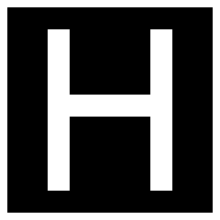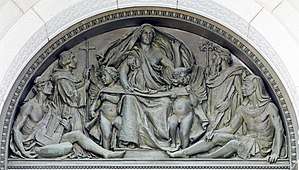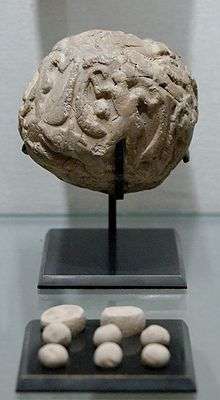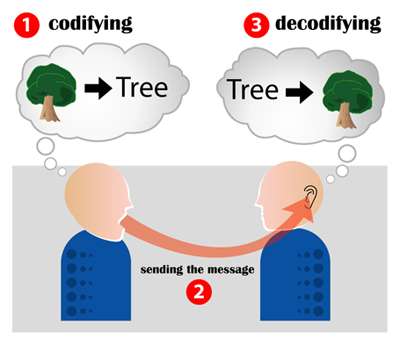Writing
Writing is a medium of human communication that involves the representation of a language with symbols. Writing systems are not themselves human languages (with the debatable exception of computer languages); they are means of rendering a language into a form that can be reconstructed by other humans separated by time and/or space.[1][2] While not all languages utilize a writing system, those with systems of inscriptions can complement and extend capacities of spoken language by enabling the creation of durable forms of speech that can be transmitted across space (e.g., correspondence) and stored over time (e.g., libraries or other public records).[3] It has also been observed that the activity of writing itself can have knowledge-transforming effects, since it allows humans to externalize their thinking in forms that are easier to reflect on and potentially rework.[4] Writing relies on many of the same semantic structures as the speech it represents, such as lexicon and syntax, with the added dependency of a system of symbols to represent that language's phonology and morphology. The result of the activity of writing is called a text, and the interpreter or activator of this text is called a reader.[5]
As human societies emerged, collective motivations for the development of writing were driven by pragmatic exigencies like keeping history, maintaining culture, codifying knowledge through curricula and lists of texts deemed to contain foundational knowledge (e.g., The Canon of Medicine) or to be artistically exceptional (e.g., a literary canon), organizing and governing societies through the formation of legal systems, census records, contracts, deeds of ownership, taxation, trade agreements, treaties, and so on.[6] For H.G. Wells, writing "made the growth of states larger than the old city states possible. It made a continuous historical consciousness possible. The command of the priest or king and his seal could go far beyond his sight and voice and could survive his death".[7] For example, around the 4th millennium BC, the complexity of trade and administration in Mesopotamia outgrew human memory, and writing became a more dependable method of recording and presenting transactions in a permanent form.[8] In both ancient Egypt and Mesoamerica, on the other hand, writing may have evolved through calendric and political necessities for recording historical and environmental events.
Individual motivations for writing include improvised additional capacity for the limitations of human memory (e.g., to-do lists, recipes, reminders, logbooks, maps, the proper sequence for a complicated task or important ritual), dissemination of ideas (as in an essay, monograph, broadside, petition, or manifesto), imaginative narratives and other forms of storytelling, personal or business correspondence, and lifewriting (e.g., a diary or journal).
Writing systems
The major writing systems—methods of inscription—broadly fall into five categories: logographic, syllabic, alphabetic, featural, and ideographic (symbols for ideas). A sixth category, pictographic, is insufficient to represent language on its own, but often forms the core of logographies.
Logographies

A logogram is a written character which represents a word or morpheme. A vast number of logograms are needed to write Chinese characters, cuneiform, and Mayan, where a glyph may stand for a morpheme, a syllable, or both—("logoconsonantal" in the case of hieroglyphs). Many logograms have an ideographic component (Chinese "radicals", hieroglyphic "determiners"). For example, in Mayan, the glyph for "fin", pronounced "ka", was also used to represent the syllable "ka" whenever the pronunciation of a logogram needed to be indicated, or when there was no logogram. In Chinese, about 90% of characters are compounds of a semantic (meaning) element called a radical with an existing character to indicate the pronunciation, called a phonetic. However, such phonetic elements complement the logographic elements, rather than vice versa.
The main logographic system in use today is Chinese characters, used with some modification for the various languages or dialects of China, Japan, and sometimes in Korean despite the fact that in South and North Korea, the phonetic Hangul system is mainly used.
Syllabaries
A syllabary is a set of written symbols that represent (or approximate) syllables. A glyph in a syllabary typically represents a consonant followed by a vowel, or just a vowel alone, though in some scripts more complex syllables (such as consonant-vowel-consonant, or consonant-consonant-vowel) may have dedicated glyphs. Phonetically related syllables are not so indicated in the script. For instance, the syllable "ka" may look nothing like the syllable "ki", nor will syllables with the same vowels be similar.
Syllabaries are best suited to languages with a relatively simple syllable structure, such as Japanese. Other languages that use syllabic writing include the Linear B script for Mycenaean Greek; Sequoyan,[9] Ndjuka, an English-based creole language of Surinam; and the Vai script of Liberia. Most logographic systems have a strong syllabic component. Ethiopic, though technically an abugida, has fused consonants and vowels together to the point where it is learned as if it were a syllabary.
Alphabets

An alphabet is a set of symbols, each of which represents or historically represented a phoneme of the language. In a perfectly phonological alphabet, the phonemes and letters would correspond perfectly in two directions: a writer could predict the spelling of a word given its pronunciation, and a speaker could predict the pronunciation of a word given its spelling.
As languages often evolve independently of their writing systems, and writing systems have been borrowed for languages they were not designed for, the degree to which letters of an alphabet correspond to phonemes of a language varies greatly from one language to another and even within a single language.
Abjads
In most of the writing systems of the Middle East, it is usually only the consonants of a word that are written, although vowels may be indicated by the addition of various diacritical marks. Writing systems based primarily on marking the consonant phonemes alone date back to the hieroglyphs of ancient Egypt. Such systems are called abjads, derived from the Arabic word for "alphabet".
Abugidas
In most of the alphabets of India and Southeast Asia, vowels are indicated through diacritics or modification of the shape of the consonant. These are called abugidas. Some abugidas, such as Ethiopic and Cree, are learned by children as syllabaries, and so are often called "syllabics". However, unlike true syllabaries, there is not an independent glyph for each syllable.
Sometimes the term "alphabet" is restricted to systems with separate letters for consonants and vowels, such as the Latin alphabet, although abugidas and abjads may also be accepted as alphabets. Because of this use, Greek is often considered to be the first alphabet.
Featural scripts
A featural script notates in an internally consistent way the building blocks of the phonemes that make up a language. For instance, all sounds pronounced with the lips ("labial" sounds) may have some element in common. In the Latin alphabet, this is accidentally the case with the letters "b" and "p"; however, labial "m" is completely dissimilar, and the similar-looking "q" and "d" are not labial. In Korean hangul, however, all four labial consonants are based on the same basic element, but in practice, Korean is learned by children as an ordinary alphabet, and the featural elements tend to pass unnoticed.
Another featural script is SignWriting, the most popular writing system for many sign languages, where the shapes and movements of the hands and face are represented iconically. Featural scripts are also common in fictional or invented systems, such as J.R.R. Tolkien's Tengwar.
Historical significance of writing systems

Historians draw a sharp distinction between prehistory and history, with history defined by the advent of writing. The cave paintings and petroglyphs of prehistoric peoples can be considered precursors of writing, but they are not considered true writing because they did not represent language directly.
Writing systems develop and change based on the needs of the people who use them. Sometimes the shape, orientation, and meaning of individual signs changes over time. By tracing the development of a script, it is possible to learn about the needs of the people who used the script as well as how the script changed over time.
Tools and materials
The many tools and writing materials used throughout history include stone tablets, clay tablets, bamboo slats, papyrus, wax tablets, vellum, parchment, paper, copperplate, styluses, quills, ink brushes, pencils, pens, and many styles of lithography. The Incas used knotted cords known as quipu (or khipu) for keeping records.[10]
The typewriter and various forms of word processors have subsequently become widespread writing tools, and various studies have compared the ways in which writers have framed the experience of writing with such tools as compared with the pen or pencil.[11][12][13][14][15]
History
Mesoamerica
A stone slab with 3,000-year-old writing, known as the Cascajal Block, was discovered in the Mexican state of Veracruz and is an example of the oldest script in the Western Hemisphere, preceding the oldest Zapotec writing by approximately 500 years.[16][17][18] It is thought to be Olmec.
Of several pre-Columbian scripts in Mesoamerica, the one that appears to have been best developed, and the only one to be deciphered, is the Maya script. The earliest inscription identified as Maya dates to the 3rd century BC.[19] Maya writing used logograms complemented by a set of syllabic glyphs, somewhat similar in function to modern Japanese writing.
Central Asia
In 2001, archaeologists discovered that there was a civilization in Central Asia that used writing c. 2000 BC. An excavation near Ashgabat, the capital of Turkmenistan, revealed an inscription on a piece of stone that was used as a stamp seal.[20]
China
The earliest surviving examples of writing in China—inscriptions on so-called "oracle bones", tortoise plastrons and ox scapulae used for divination—date from around 1200 BC in the late Shang dynasty. A small number of bronze inscriptions from the same period have also survived.[21] Historians have found that the type of media used had an effect on what the writing was documenting and how it was used.
In 2003, archaeologists reported discoveries of isolated tortoise-shell carvings dating back to the 7th millennium BC, but whether or not these symbols are related to the characters of the later oracle-bone script is disputed.[22][23]
Egypt

The earliest known hieroglyphic date back to the second half of the 4th millennium BC, such as the clay labels of a Predynastic ruler called "Scorpion I" (Naqada IIIA period, c. 32nd century BC) recovered at Abydos (modern Umm el-Qa'ab) in 1998 or the Narmer Palette, dating to c. 3100 BC, and several recent discoveries that may be slightly older, though these glyphs were based on a much older artistic rather than written tradition. The hieroglyphic script was logographic with phonetic adjuncts that included an effective alphabet. The world's oldest deciphered sentence was found on a seal impression found in the tomb of Seth-Peribsen at Umm el-Qa'ab, which dates from the Second Dynasty (28th or 27th century BC). There are around 800 hieroglyphs dating back to the Old Kingdom, Middle Kingdom and New Kingdom Eras. By the Greco-Roman period, there are more than 5,000.
Writing was very important in maintaining the Egyptian empire, and literacy was concentrated among an educated elite of scribes. Only people from certain backgrounds were allowed to train to become scribes, in the service of temple, pharaonic, and military authorities, resulting in only 1 percent of the population that could write.[24] The hieroglyph system was always difficult to learn, but in later centuries was purposely made even more so, as this preserved the scribes' status.
The world's oldest known alphabet appears to have been developed by Canaanite turquoise miners in the Sinai desert around the mid-19th century BC.[25] Around 30 crude inscriptions have been found at a mountainous Egyptian mining site known as Serabit el-Khadem. This site was also home to a temple of Hathor, the "Mistress of turquoise". A later, two line inscription has also been found at Wadi el-Hol in Central Egypt. Based on hieroglyphic prototypes, but also including entirely new symbols, each sign apparently stood for a consonant rather than a word: the basis of an alphabetic system. It was not until the 12th to 9th centuries, however, that the alphabet took hold and became widely used.
Elamite scripts
Over the centuries, three distinct Elamite scripts developed. Proto-Elamite is the oldest known writing system from Iran. In use only for a brief time (c. 3200–2900 BC), clay tablets with Proto-Elamite writing have been found at different sites across Iran. The Proto-Elamite script is thought to have developed from early cuneiform (proto-cuneiform). The Proto-Elamite script consists of more than 1,000 signs and is thought to be partly logographic.
Linear Elamite is a writing system attested in a few monumental inscriptions in Iran. It was used for a very brief period during the last quarter of the 3rd millennium BC. It is often claimed that Linear Elamite is a syllabic writing system derived from Proto-Elamite, although this cannot be proven since Linear-Elamite has not been deciphered. Several scholars have attempted to decipher the script, most notably Walther Hinz and Piero Meriggi.
The Elamite cuneiform script was used from about 2500 to 331 BC, and was adapted from the Akkadian cuneiform. The Elamite cuneiform script consisted of about 130 symbols, far fewer than most other cuneiform scripts.
Cretan and Greek scripts
Cretan hieroglyphs are found on artifacts of Crete (early-to-mid-2nd millennium BC, MM I to MM III, overlapping with Linear A from MM IIA at the earliest). Linear B, the writing system of the Mycenaean Greeks,[26] has been deciphered while Linear A has yet to be deciphered. The sequence and the geographical spread of the three overlapping, but distinct writing systems can be summarized as follows (beginning date refers to first attestations, the assumed origins of all scripts lie further back in the past): Cretan hieroglyphs were used in Crete from c. 1625 to 1500 BC; Linear A was used in the Aegean Islands (Kea, Kythera, Melos, Thera), and the Greek mainland (Laconia) from c. 18th century to 1450 BC; and Linear B was used in Crete (Knossos), and mainland (Pylos, Mycenae, Thebes, Tiryns) from c. 1375 to 1200 BC.
Indus Valley
Indus script refers to short strings of symbols associated with the Indus Valley Civilization (which spanned modern-day Pakistan and North India) used between 2600 and 1900 BC. In spite of many attempts at decipherments and claims, it is as yet undeciphered. The term 'Indus script' is mainly applied to that used in the mature Harappan phase, which perhaps evolved from a few signs found in early Harappa after 3500 BC,[27] and was followed by the mature Harappan script. The script is written from right to left,[28] and sometimes follows a boustrophedonic style. Since the number of principal signs is about 400–600,[29] midway between typical logographic and syllabic scripts, many scholars accept the script to be logo-syllabic[30] (typically syllabic scripts have about 50–100 signs whereas logographic scripts have a very large number of principal signs). Several scholars maintain that structural analysis indicates that an agglutinative language underlies the script.
Mesopotamia
While neolithic writing is a current research topic, conventional history assumes that the writing process first evolved from economic necessity in the ancient Near East. Writing most likely began as a consequence of political expansion in ancient cultures, which needed reliable means for transmitting information, maintaining financial accounts, keeping historical records, and similar activities. Around the 4th millennium BC, the complexity of trade and administration outgrew the power of memory, and writing became a more dependable method of recording and presenting transactions in a permanent form.[31]
The invention of the first writing systems is roughly contemporary with the beginning of the Bronze Age of the late 4th millennium BC. The Sumerian archaic cuneiform script and the Egyptian hieroglyphs are generally considered the earliest writing systems, both emerging out of their ancestral proto-literate symbol systems from 3400 to 3200 BC with earliest coherent texts from about 2600 BC. It is generally agreed that Sumerian writing was an independent invention; however, it is debated whether Egyptian writing was developed completely independently of Sumerian, or was a case of cultural diffusion.

Archaeologist Denise Schmandt-Besserat determined the link between previously uncategorized clay "tokens", the oldest of which have been found in the Zagros region of Iran, and the first known writing, Mesopotamian cuneiform.[32] In approximately 8000 BC, the Mesopotamians began using clay tokens to count their agricultural and manufactured goods. Later they began placing these tokens inside large, hollow clay containers (bulla, or globular envelopes) which were then sealed. The quantity of tokens in each container came to be expressed by impressing, on the container's surface, one picture for each instance of the token inside. They next dispensed with the tokens, relying solely on symbols for the tokens, drawn on clay surfaces. To avoid making a picture for each instance of the same object (for example: 100 pictures of a hat to represent 100 hats), they 'counted' the objects by using various small marks. In this way the Sumerians added "a system for enumerating objects to their incipient system of symbols".
The original Mesopotamian writing system was derived around 3200 BC from this method of keeping accounts. By the end of the 4th millennium BC,[33] the Mesopotamians were using a triangular-shaped stylus pressed into soft clay to record numbers. This system was gradually augmented with using a sharp stylus to indicate what was being counted by means of pictographs. Round-stylus and sharp-stylus writing was gradually replaced by writing using a wedge-shaped stylus (hence the term cuneiform), at first only for logograms, but by the 29th century BC also for phonetic elements. Around 2700 BC, cuneiform began to represent syllables of spoken Sumerian. About that time, Mesopotamian cuneiform became a general purpose writing system for logograms, syllables, and numbers. This script was adapted to another Mesopotamian language, the East Semitic Akkadian (Assyrian and Babylonian) around 2600 BC, and then to others such as Elamite, Hattian, Hurrian and Hittite. Scripts similar in appearance to this writing system include those for Ugaritic and Old Persian. With the adoption of Aramaic as the 'lingua franca' of the Neo-Assyrian Empire (911–609 BC), Old Aramaic was also adapted to Mesopotamian cuneiform. The last cuneiform scripts in Akkadian discovered thus far date from the 1st century AD.
Phoenician writing system and descendants
The Proto-Sinaitic script, in which Proto-Canaanite is believed to have been first written, is attested as far back as the 19th century BC. The Phoenician writing system was adapted from the Proto-Canaanite script sometime before the 14th century BC, which in turn borrowed principles of representing phonetic information from Egyptian hieroglyphs. This writing system was an odd sort of syllabary in which only consonants are represented. This script was adapted by the Greeks, who adapted certain consonantal signs to represent their vowels. The Cumae alphabet, a variant of the early Greek alphabet, gave rise to the Etruscan alphabet and its own descendants, such as the Latin alphabet and Runes. Other descendants from the Greek alphabet include Cyrillic, used to write Bulgarian, Russian and Serbian, among others. The Phoenician system was also adapted into the Aramaic script, from which the Hebrew and the Arabic scripts are descended.
The Tifinagh script (Berber languages) is descended from the Libyco-Berber script, which is assumed to be of Phoenician origin.
Modern importance
In many parts of the world, writing has become an even more important part of daily life as digital technologies have helped connect individuals from across the globe through systems such as e-mail and social media. Such technologies have brought substantial amounts of routine reading and writing into most modern workplaces.[34] In the United States, for example, the ability to read and write is necessary for most jobs, and multiple programs are in place to aid both children and adults in improving their literacy skills. For example, the emergence of the writing center and community-wide literacy councils aim to help students and community members sharpen their writing skills. These resources, and many more, span across different age groups in order to offer each individual a better understanding of their language and how to express themselves via writing in order to perhaps improve their socioeconomic status.
Other parts of the world have seen an increase in writing abilities as a result of programs such as the World Literacy Foundation and International Literacy Foundation, as well as a general push for increased global communication.
See also
- Asemic writing
- Author
- Boustrophedon text
- Calligraphy
- Collaborative writing
- Communication
- Composition (language)
- Composition studies
- Copyright Clause
- Creative writing
- Decipherment
- Dyslexia
- Essay
- Fiction writing
- Foreign language writing aid
- Graphonomics
- Handwriting
- Interactive fiction
- Journalism
- Kishōtenketsu
- Linguistics
- List of discoveries of writings
- List of writers' conferences
- Literacy
- Literary award
- Literary criticism
- Literary festival
- Literature
- Manuscript
- Mechanical pencil
- Orthography
- Peer critique
- Pencil
- Printing
- Publishing
- Creation of the Sequoyah syllabary
- Scriptorium
- Story bible
- Speech communication
- Teaching Writing in the United States
- Textual scholarship
- Typography
- White papers
- Word processing
- Writer
- Writer's block
- Writing bump
- Writing circle
- Writing in space
- Writing slate
- Writing style
- Writing systems
- Writer's voice
Notes
References
- Ong, Walter (1982). Orality and Literacy: The Technologizing of the Word. London: Methuen. ISBN 9780415027960.
- Haas, Christina. (1996). Writing technology: Studies on the materiality of literacy. Mahwah, NJ: L. Erlbaum Associates.
- Schmandt-Besserat, Denise and Michael Erard. (2008) "Origins and Forms of Writing." Handbook of Research on Writing: History, Society, School, Individual, Text. Charles Bazerman, ed. New York: Lawrence Erlbaum Associates, 7-21 [21].
- Estrem, Heidi. "Writing is a Knowledge-Making Activity." Naming What We Know: Threshold Concepts of Writing Studies. L. Adler-Kassner & E. Wardle, eds. Logan: Utah State University Press, 2015: 55-56.
- Smith, Dorothy E. (2005). Institutional Ethnography: A Sociology for People. Lanham, MD: Rowman & Littlefield. pp. 105–108. ISBN 978-0-7591-0502-7.
- Anderson, Jack. (2008). "The Collection and Organization of Written Knowledge." In Handbook of Research on Writing, ed. Charles Bazerman, New York: Lawrence Erlbaum Associates, 177-190.
- Wells, H. G. (1922). A Short History of the World. p. 41.
- Green, M.W. (1981). "The Construction and Implementation of the Cuneiform Writing System". Visible Language. 15.4: 345–372.
- Cushman, Ellen (2011). "The Cherokee Syllabary: A Writing System in its Own Right". Written Communication. 28 (3): 255–281. doi:10.1177/0741088311410172.
- "The Khipu Database Project".
- Chandler, Daniel (1990). "Do the write thing?". Electric Word. 17: 27–30.
- Chandler, Daniel (1992). "The phenomenology of writing by hand". Intelligent Tutoring Media. 3 (2/3): 65–74. doi:10.1080/14626269209408310.
- Chandler, Daniel (1993). "Writing strategies and writers' tools". English Today: The International Review of the English Language. 9 (2): 32–38. doi:10.1017/S0266078400000341.
- Chandler, Daniel (1994). "Who needs suspended inscription?". Computers and Composition. 11 (3): 191–201. doi:10.1016/8755-4615(94)90012-4.
- Chandler, Daniel (1995). The Act of Writing: A Media Theory Approach. Aberystwyth: Prifysgol Cymru.
- Wilford, John Noble (15 September 2006). "Writing May Be Oldest in Western Hemisphere". New York Times. Retrieved 30 March 2008.
A stone slab bearing 3,000-year-old writing previously unknown to scholars has been found in the Mexican state of Veracruz, and archaeologists say it is an example of the oldest script ever discovered in the Western Hemisphere.
- Briggs, Helen (14 September 2006). "'Oldest' New World writing found". BBC. Retrieved 30 March 2008.
Ancient civilisations in Mexico developed a writing system as early as 900 BC, new evidence suggests.
- Rodríguez Martínez, Maria del Carmen; et al. (2006). "Oldest Writing in the New World". Science. 313 (5793): 1610–1614. Bibcode:2006Sci...313.1610R. doi:10.1126/science.1131492. PMID 16973873. Retrieved 30 March 2008.
A block with a hitherto unknown system of writing has been found in the Olmec heartland of Veracruz, Mexico. Stylistic and other dating of the block places it in the early first millennium before the common era, the oldest writing in the New World, with features that firmly assign this pivotal development to the Olmec civilization of Mesoamerica.
- Saturno, William A.; David Stuart; Boris Beltrán (3 March 2006). "Early Maya Writing at San Bartolo, Guatemala". Science. 311 (5765): 1281–1283. Bibcode:2006Sci...311.1281S. doi:10.1126/science.1121745. PMID 16400112.
- "Ancient writing found in Turkmenistan". BBC. 15 May 2001. Retrieved 30 March 2008.
A previously unknown civilisation was using writing in Central Asia 4,000 years ago, hundreds of years before Chinese writing developed, archaeologists have discovered. An excavation near Ashgabat, the capital of Turkmenistan, revealed an inscription on a piece of stone that seems to have been used as a stamp seal.
- Boltz, William (1999). "Language and Writing". In Loewe, Michael; Shaughnessy, Edward L. (eds.). The Cambridge History of Ancient China. Cambridge: Cambridge University Press. pp. 74–123. ISBN 978-0-521-47030-8.
- "Archaeologists Rewrite History". China Daily. 12 June 2003. Retrieved 4 January 2012.
-
Rincon, Paul (17 April 2003). "'Earliest writing' found in China". BBC News. Retrieved 4 January 2012.
Signs carved into 8,600-year-old tortoise shells found in China may be the earliest written words, say archaeologists
- Lyons, Martyn (2011). Books: A Living History. United States: Getty Publications. p. 15. ISBN 978-1-60606-083-4.
- Goldwasser, Orly. "How the Alphabet Was Born from Hieroglyphs", Biblical Archaeology Review, Mar/Apr 2010
- Oliver, J.P. (1986). "Cretan writing in the second millennium B.C." World Archaeology. 17 (3): 377–389. doi:10.1080/00438243.1986.9979977.
- Whitehouse, David (1999). "'Earliest writing' found" BBC
- (Lal 1966)
- (Wells 1999)
- (Bryant 2000)
- Robinson 2003, p. 36.
- Rudgley, Richard (2000). The Lost Civilizations of the Stone Age. New York: Simon & Schuster. pp. 48–57.
- The Origin and Development of the Cuneiform System of Writing, Samuel Noah Kramer, Thirty Nine Firsts in Recorded History pp. 381–383
- Brandt, Deborah (2015). The Rise of Writing. Cambridge UP. ISBN 978-1-107-46211-3.
Further reading
- A History of Writing: From Hieroglyph to Multimedia, edited by Anne-Marie Christin, Flammarion (in French, hardcover: 408 pages, 2002, ISBN 2-08-010887-5)
- In the Beginning: A Short History of the Hebrew Language. By Joel M. Hoffman, 2004. Chapter 3 covers the invention of writing and its various stages.
- Origins of writing on AncientScripts.com
- Museum of Writing: UK Museum of Writing with information on writing history and implements
- On ERIC Digests: Writing Instruction: Current Practices in the Classroom; Writing Development; Writing Instruction: Changing Views over the Years
- Angioni, Giulio, La scrittura, una fabrilità semiotica, in Fare, dire, sentire. L'identico e il diverso nelle culture, il Maestrale, 2011, 149–169. ISBN 978-88-6429-020-1
- Children of the Code: The Power of Writing – Online Video
- Powell, Barry B. 2009. Writing: Theory and History of the Technology of Civilization, Oxford: Blackwell. ISBN 978-1-4051-6256-2
- Reynolds, Jack 2004. Merleau-Ponty And Derrida: Intertwining Embodiment And Alterity, Ohio University Press
- Rogers, Henry. 2005. Writing Systems: A Linguistic Approach. Oxford: Blackwell. ISBN 0-631-23463-2 (hardcover); ISBN 0-631-23464-0 (paperback)
- Ankerl, Guy (2000) [2000]. Global communication without universal civilization. INU societal research. Vol.1: Coexisting contemporary civilizations: Arabo-Muslim, Bharati, Chinese, and Western. Geneva: INU Press. pp. 59–66, 235s. ISBN 978-2-88155-004-1.
- Robinson, Andrew (2003). "The Origins of Writing". In Crowley, David; Heyer, Paul (eds.). Communication in History: Technology, Culture, Society. Allyn and Bacon.CS1 maint: ref=harv (link)
- Falkenstein, A. 1965 Zu den Tafeln aus Tartaria. Germania 43, 269–273
- Haarmann, H. 1990 Writing from Old Europe. The Journal of Indo-European Studies 17
- Lazarovici, Gh., Fl. Drasovean & Z. Maxim 2000 The Eagle – the Bird of death, regeneration resurrection and messenger of Gods. Archaeological and ethnological problems. Tibiscum, 57–68
- Lazarovici, Gh., Fl. Drasovean & Z. Maxim 2000 The Eye – Symbol, Gesture, Expression.Tibiscum, 115–128
- Makkay, J. 1969 The Late Neolithic Tordos Group of Signs. Alba Regia 10, 9–50
- Makkay, J. 1984 Early Stamp Seals in South-East Europe. Budapest
- Masson, E. 1984 L'écriture dans les civilisations danubiennes néolithiques. Kadmos 23, 2, 89–123. Berlin & New York.
- Maxim, Z. 1997 Neo-eneoliticul din Transilvania. Bibliotheca Musei Napocensis 19. Cluj-Napoca
- Milojcic, Vl. 1963 Die Tontafeln von Tartaria (Siebenbürgen), und die Absolute Chronologie des mitteleeuropäischen Neolithikums.Germania 43, 266–268
- Paul, I. 1990 Mitograma de acum 8 milenii. Atheneum 1, p. 28
- Paul, I. 1995 Vorgeschichtliche untersuchungen in Siebenburgen. Alba Iulia
- Vlassa, N. 1962 – (Studia UBB 2), 23–30.
- Vlassa, N. 1962 – (Dacia 7), 485–494;
- Vlassa, N. 1965 – (Atti UISPP, Roma 1965), 267–269
- Vlassa, N. 1976 Contribuții la Problema racordării Neoliticul Transilvaniei, p. 28–43, fig. 7-8
- Vlassa, N. 1976 Neoliticul Transilvaniei. Studii, articole, note. Bibliotheca Musei Napocensis 3. Cluj-Napoca
- Winn, Sham M. M. 1973 The Sings of the Vinca Culture
- Winn, Sham M. M. 1981 Pre-writing in Southeast Europe: The Sign System of the Vinca culture. BAR
- Merlini, Marco 2004 La scrittura è natta in Europa?, Roma (2004)
- Merlini, Marco and Gheorghe Lazarovici 2008 Luca, Sabin Adrian ed. "Settling discovery circumstances, dating and utilization of the Tărtăria Tablets"
- Merlini, Marco and Gheorghe Lazarovici 2005 "New archaeological data referring to Tărtăria tablets", in Documenta Praehistorica XXXII, Department of Archeology Faculty of Arts, University of Ljubljana. Ljubljana:2005–2019.
External links
| Wikiquote has quotations related to: Writing |
| Wikimedia Commons has media related to People writing. |
| Wikiversity has learning resources about Collaborative play writing |
| Wikibooks has a book on the topic of: Fiction technique |
| Look up writing in Wiktionary, the free dictionary. |
